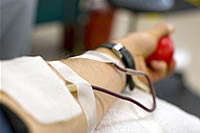Life Insurance Medical Exam: What Do They Test For?

Preparing for an Insurance Medical Exam
All insurance companies require a “mini physical” exam to obtain a policy. The insurance exam is completed by a licensed examiner who will contact you to set-up an appointment at your convenience. The exam can be completed at your home or office. The exam consists of a blood and urine sample, height and weight check, blood pressure measurement and a detailed review of your medical history. On some occasions, an electrocardiogram (EKG) may be required depending upon the insurance company. For more specifics about how the exam is conducted, go to: http://www.keypersoninsurance.com/about_paramedical_exams.php
Other related terms include Lab Results, Medical Exams, Medical Tests, Exam Requirements, Blood Test, and Lab Work. Read below for more information on receiving a life insurance quote from a life insurance specialist.
Follow these few suggestions prior to the medical exam to optimize results:
-
- Get a good night’s sleep the night before the examination
- Abstain from alcoholic beverages for at least eight hours prior to the exam
- Do not smoke or chew tobacco for at least one hour prior to your examination
- Avoid drinking coffee, tea or caffeinated soft drinks for at least one hour prior to your examination
- Limit salt intake and high cholesterol foods 24 hours before your examination
- Do not engage in strenuous physical activities 24 hours before the examination
- Advise the Paramedical Examiner of any medications you are taking, even non-prescription medications
- Provide a list of your physicians’ names and addresses, dates of past visits, names of prescribed medications and any information regarding injury and/or major illness during the previous five years
- If you belong to Kaiser or any other prepaid medical plan, have your medical record number available
- Drink a glass of water an hour or so before your appointment to aid in providing a urine specimen
- If a blood specimen is required, fast according to provider directives prior to the examination unless otherwise instructed
Understanding Blood Chemistry and Urine Analysis Reports
A review of this glossary of terms, related to blood chemistry and urine analysis, will explain what general levels reveal with regard to your health and your insurance application. The blood that is drawn during the physical exam will be processed and checked for the following substances and levels:
- Albumin: The largest portion of total serum protein. Decreased serum albumin can indicate many disorders, including advanced liver disease. Results may be affected by increased amounts of steroids, androgens and insulin.
- Alkaline Phosphatase: An enzyme found primarily in the liver and bones. Elevated levels may indicate the presence of bone disorders as well as a variety of lever and bile duct diseases. Results may be affected by pregnancy and not fasting before the test. Kids tend to have elevations especially during the developmental years. Medications do not typically affect the results.
- Bilirubin Total: Levels that are abnormally high may occur in individuals with liver and gallbladder disease, sometimes producing jaundice. Results showing elevations with normal liver function abnormalities are rarely significant.
- Blood Urea Nitrogen (BUN): An end-product of metabolism; levels are used to detect the presence of kidney diseases. Results may be affected by high protein diets and are usually viewed along with creatinine results to determine total kidney function.
- Cholesterol/HDL: This ratio is a predictor of coronary artery disease. A ratio of 4.5 or less is associated with lower risk of heart disease. Results may be affected by not fasting before the blood is drawn and by pregnancy.
- Creatinine: A waste product released from muscle tissue and excreted from the kidneys. Like BUN, creatinine measurements also are used to screen for kidney disorders. Results may be affected by a few medications and delays in processing the lab sample.
- Fructosamine: Measures ‘glycated serum proteins’, a person’s average blood sugar concentration over the past two to three weeks. These levels can help detect diabetes. Results may be affected by hemolysis.
- Gamma Glutamyl Transpeptidase (GGT, GGTP): An enzyme commonly included in the group of results called the liver function tests. It may be elevated when alcoholism, cirrhosis, hepatitis, carcinoma, cholestasis, obstructive jaundice, and hepatotoxicity are affecting the liver. Results may be affected by many medications, tobacco use, and build. This test is quite controversial and should be used in conjunction with other liver panel studies like the SGPT (ALT) and SGOT (AST) before determining a prognosis. It is quite helpful in applicants that have a history of alcohol abuse.
- Globulin: A major component of serum proteins. It has many functions including maintenance of the immune system. Abnormal globulin levels, both elevated and decreased, may indicate infections, allergic states, immune disorders and other diseases. Results indicating elevation or depression of levels reflect the aforementioned conditions.
- Glucose: The main source of energy for living organisms. The most important cause of elevated glucose is diabetes mellitus, but other impairments can also elevate glucose levels in the blood and urine. Results may be affected by stress, trauma, heart attacks, and caffeine.
- Glycohemoglobin or Hemoglobin A1C: Shows the amount of glucose in the blood over six or more weeks and is an effective tool in monitoring the control of diabetes. Insurance companies do not routinely test for A1C unless there is an abnormal glucose level. Results may be affected by hemolysis or sickle cell abnormalities.
- High Density Lipoprotein (HDL): The quantity of HDL, as well as the ratio of HDL to total cholesterol, is important in determining one’s risk of coronary artery disease. Markedly elevated HDL may also indicate heavy alcohol intake. Results may be affected by alcohol use, tobacco use and exercise.
- Low- Density Lipoprotein (LDL): LDL levels are important in determining a person’s risk of coronary artery disease. Results may be affected by a not fasting before a blood sample is drawn. Blood should not be drawn until six weeks after an acute illness has cleared the body.
- LDL/HDL: This ratio is calculated using total cholesterol, HDL and triglycerides measurements and is an accurate predictor of coronary artery disease. The lower the LDL/HDL ratio, the less the risk of coronary problems.
- Aspartate Aminotransferase (SGOT /AST): An enzyme found in the liver as well as cardiac and skeletal muscle. Elevated levels can indicate liver and muscle disorders. Results may be affected by prescription medications or strenuous activity.
- Alanine Aminotransferase (SGPT/ ALT): An enzyme found in muscle, cardiac and liver cells. Elevated levels commonly occur with liver disease and are often proportional to the degree of disease. Results may be affected by strenuous activity or several prescription medications. This information should be correlated before making any assumptions.
- Total Cholesterol: A primary risk factor for coronary artery disease which can be controlled. Elevated cholesterol levels are associated with atherosclerosis and heart attacks. Abnormal cholesterol levels may also indicate other disorders in the body.
- Total Protein: Measurement in serum analysis includes two major components, albumin and globulin, and assesses the body’s ability to maintain its chemical balance. Results may be affected by strenuous activity or several prescription medications. This information should be correlated before making any assumptions.
- Triglycerides: Increases in triglycerides, fats that provide a major reserve of energy for the body, and other fats (lipids) are used to help predict the risk of coronary artery disease. Ideally, triglycerides should be measured after an overnight fast. Results may be affected by not fasting at least 10 hours before the blood is drawn and the consumption of alcohol within 24 hours of the blood draw.
Urine collected will be screened for the following:
- Cotinine: The major metabolite of nicotine. This test, which can be performed on both urine and blood serum, distinguishes tobacco users from non-tobacco users.
- Creatinine: A product released from muscle tissue and excreted from the kidneys. Creatinine measurements also are used to screen for kidney disorders.
- Glucose: Elevated glucose levels are indicative of diabetes mellitus and other conditions.
- Granular Casts: Protein masses that form in the kidneys are excreted through the urine and are used in detecting inflammation or hemorrhaging.
- Hyaline Casts: A form of protein mass that can indicated kidney or heart disease.
- Protein: A combination of complex amino acids that make up our body cells. Abnormal cell levels may indicate the presence of kidney disease.
- Protein/Creatinine Ratio: This ratio is more specific than an isolated protein measurement. It can help determine whether the protein is elevated due to possible disease or urine concentration.
- Red Blood Cells: Not typically carried in urine, therefore, a higher than average reading could indicate the presence of kidney diseases. The exception is menstruating females.
- Specific Gravity: Used to check renal or kidney functions. The presence of glucose or protein may cause higher than expected readings.
- White Blood Cells: The presence of white blood cells indicates the presence of a urinary tract infection or inflammation of the urinary tract
Lab work results will be analyzed and sent to the insurance company for evaluation
Awaiting Application Approval
The process of filing for life insurance is not complicated, however, it takes time. The underwriting process begins when your application and exam have been received by the insurance company. During this process, a representative at the insurance company will review your application and exam paperwork, order your lab results from the lab and request any medical records from your attending physicians. They may also request your driving record as well as a brief telephone interview to verify the accuracy of your information. The underwriting process should be expected to take 4-5 weeks depending on the specific requirements needed. Upon acceptance, you will be notified immediately. If concerns are raised by the results from the medical exam, blood work or urinalysis,
How Can MEG Financial Help?
At MEG Financial, we have worked with many individuals across the country that have had related histories and have helped many obtain fairly priced life insurance. A number of these clients previously attempted to buy life insurance elsewhere but were either turned down or asked to pay a significantly higher rate. Our experience helping others with related problems is invaluable to you in identifying the insurance company that will treat you most fairly.
For more specific information or to obtain a custom quote, call MEG Financial today at (877) 583-3955. You may also submit this short form and an independent insurance agent will personally contact you to go over any questions or other concerns.

 Speak with an experienced advisor!
Speak with an experienced advisor! 


